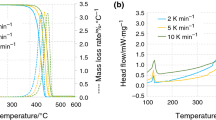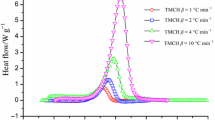Abstract
This paper introduces a simple and new correlation between the impact sensitivity and activation energy for pyrotechnic compositions where both the fuel and oxidizer are inorganic in nature. The database consists of various drop height (impact sensitivity) and activation energy values obtained from in-house experimentation and various literature studies. This paper also proposes a method to calculate the activation energy from the thermal properties obtained using only single-heating-rate differential scanning calorimetry experimental data. The correlation coefficient between the impact sensitivity and activation energy is found to be 0.84.


Similar content being viewed by others
REFERENCES
M. Surianarayanan, S. P. Sivapirakasam, and G. Swaminathan, “Accident Data Analysis and Hazard Assessment in Fireworks Manufacture," Sci. Technol. Energ. Mater. 69 (5), 161–168 (2008).
S. P. Sivapirakasam, M. Surianarayanan, and G. Swaminathan, “Hazard Assessment for the Safe Storage, Manufacturing and Handling of Flash Compositions," J. Loss Prev. Process Ind. 22 (2), 254–256 (2009).
United Nations. Recommendations on the Transport of Dangerous Goods: Manual of Tests and Criteria (New York–Geneva, United Nat. Publ., 2009).
M. J. Kamlet and H. G. Adolph, “The Relationship of Impact Sensitivity with Structure of Organic High Explosives. II. Polynitroaromatic Explosives," Propell., Explos., Pyrotech.4 (2), 30–34 (1979).
R. Wang, J. Jiang, Y. Pan, et al., “Prediction of Impact Sensitivity of Nitro Energetic Compounds by Neural Network Based on Electrotopological-State Indices," J. Hazard. Mater.166 (1), 155–186 (2009).
M. H. Keshavarz, “A New General Correlation for Predicting Impact Sensitivity of Energetic Compounds," Propell., Explos., Pyrotech.38 (6), 754–760 (2013).
A. A. Denisaev, B. L. Korsunskii, V. I. Perepekin, and Yu. N. Matyushin, “Impact Sensitivity of Liquid Explosives," Fiz. Goremiya Vzryva 46 (1), 85–92 (2010) [Combust., Expl., Shock Waves 46 (1), 74–80 (2010)].
D. Mathieu and T. Alaime, “Impact Sensitivities of Energetic Materials: Exploring the Limitations of a Model Based Only on Structural Formulas," J. Mol. Graphics Modell. 62, 81–86 (2015).
G. Ruitenberg, “Applying Kissinger Analysis to the Glass Transition Peak in Amorphous Metals," Thermochim. Acta 404(1/2), 207–211 (2003).
L. Zhang, D. Xing, and J. Sun, “Calculating Activation Energy of Amorphous Phase with the Lambert W Function," J. Therm. Anal. Calorim. 100 (1), 3–10 (2010).
M. Fathollahi and H. Behnejad, “A Comparative Study of Thermal Behaviors and Kinetics Analysis of the Pyrotechnic Compositions Containing Mg and Al," J. Therm. Anal. Calorim. 120(2), 1483–1492 (2015).
N. Selvakumar, A. Azhagurajan, and A. Suresh, “Experimental Analysis on Nano Scale Flash Powder Composition in Fireworks Manufacturing," J. Therm. Anal. Calorim. 113 (2), 615–621 (2013).
A. S. Redkar, V. A. Mujumdar, and S. Singh, “Study on Magnesium Based Pyrotechnic Composition As a Priming Charge," Defence Sci. J. 46 (1), 41–47 (1996).
J. J. Sabatini, J. M. Raab, R. K. Hann Jr, and C. T. Freeman, “Brighter- and Longer-Burning Barium-Free Illuminants for Military and Civilian Pyrotechnics," J. Inorg. General Chem. 639(1), 25–30 (2013).
J. J. Sabatini and J. D. Moretti, “High-Nitrogen-Based Pyrotechnics: Perchlorate-Free Red- and Green-Light Illuminants Based on 5-aminotetrazole," Chem. A Eur. J. 19 (38), 12839–12845 (2013).
J. D. Moretti, S. M. Harbol, D. E. Riegner, et al., “Single-Point-of-Failure Mitigation: Prove-Out of a Green Light-Emitting Illuminant Composition in the Handheld Signal Cluster and 40-mm Parachute Configurations," J. Energ. Mater.32 (4), 293–299 (2014).
J. D. Moretti, J. J. Sabatini, and J. C. Poret, “High-Performing Red-Light-Emitting Pyrotechnic Illuminants through the use of Perchlorate-Free Materials," Chem. A Eur. J. 20(28), 8800–8804 (2014).
A. Azhagurajan, N. Selvakumar, and T. L. Thanulingam, “Thermal and Sensitivity Analysis of Nano Aluminium Powder for Firework Application," J. Therm. Anal. Calorim. 105 (1), 259–267 (2011).
V. Bhingarkar and H. Singh, “Influence of Cellulosic Binders on Sensitivity and Combustion Behaviour of B–KNO3 Ignition System," Defence Sci. J. 56 (3), 345–351 (2006).
S. V. Pakkirisamy, S. Mahadevan, S. S. Paramashivan, and A. B. Mandal, “Adiabatic Thermokinetics and Process Safety of Pyrotechnic Mixtures," J. Therm. Anal. Calorim. 109 (3), 1387–1395 (2012).
A. A. Denisaev, A. S. Shteinberg, and A. A. Berlin, “Study of the Impact Sensitivity of Aluminum–Polytetrafluoroethylene Layered Compositions," Dokl. Akad. Nauk 414 (5), 636–639 (2007) [Dokl. Phys. Chem. 414 (2), 139–142 (2007)].
K. P. Phanindra, S. P. Sivapirakasam, P. Soni, and M. Surianarayanan, “Thermal Reaction Studies and Prediction of Stoichiometry of Pyrotechnic Compositions Using DSC and XRD Methods," Thermochim. Acta 675, 100–106 (2019).
Author information
Authors and Affiliations
Corresponding author
Rights and permissions
About this article
Cite this article
Sivapirakasam, S.P., Harisivasri Phanindra, K., Rohin, J. et al. Impact Sensitivity of Pyrotechnics: A Model Based on Activation Energy. Combust Explos Shock Waves 56, 592–600 (2020). https://doi.org/10.1134/S0010508220050111
Received:
Published:
Issue Date:
DOI: https://doi.org/10.1134/S0010508220050111




